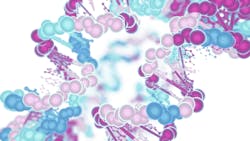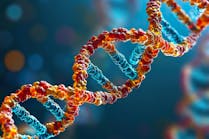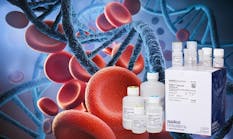In a step forward in the development of genetic medicines, researchers at Children’s Hospital of Philadelphia (CHOP) and the Perelman School of Medicine at the University of Pennsylvania have developed a proof-of-concept model for delivering gene editing tools to treat blood disorders, allowing for the modification of diseased blood cells directly within the body. If translated into the clinic, this approach could expand access and reduce the cost of gene therapies for blood disorders, many of which currently require patients receive chemotherapy and a stem cell transplant. The findings were published in the journal Science.
Hematopoietic stem cells (HSCs) reside in the bone marrow, where they divide throughout life to produce all cells within the blood and immune system. In patients with non-malignant hematopoietic disorders like sickle cell disease and immunodeficiency disorders, these blood cells don’t function correctly because they carry a genetic mutation.
For these patients, there are currently two avenues for potentially curative treatments, both of which involve a bone marrow transplant: a stem cell transplant with HSCs from a healthy donor, or gene therapy in which the patient’s own HSCs are modified outside of the body and transplanted back in (often referred to as ex vivo gene therapy). The former approach comes with the risk of graft versus host disease, given that the HSCs come from a donor, and both processes involve a conditioning regimen of chemotherapy or radiation to eliminate the patient’s diseased HSCs and prepare them to receive the new cells. These conditioning procedures come with significant toxic side effects, underscoring the need to investigate less-toxic approaches.
One option that would eliminate the need for the above methods would be in vivo gene editing, in which gene editing tools are infused directly into the patient, allowing HSCs to be edited and corrected without the need for conditioning regimens.
To validate this approach, a research team led by Laura Breda, PhD, and Michael P. Triebwasser, MD, PhD at CHOP (presently at the University of Michigan), Tyler E. Papp, BS at Penn, and Drew Weissman, MD, PhD, the Roberts Family Professor in Vaccine Research, the director of the Penn Institute for RNA Innovation, and a pioneer of mRNA-vaccine research, used liquid nanoparticle (LNP) to deliver mRNA gene editing tools. LNP are highly effective at packaging and delivering mRNA to cells and became widely utilized in 2020, due to the LNP-mRNA platform for two leading COVID-19 vaccines.
However, in the case of the COVID-19 vaccines, the LNP-mRNA construct did not target specific cells or organs within the body. Given that the researchers wanted to target HSCs specifically, they decorated the surface of their experimental LNPs with antibodies that would recognize CD117, a receptor on the surface of HSCs. They then pursued three approaches to test the efficacy of their CD117/LNP formulation.
First, the researchers tested CD117/LNP encapsulating reporter mRNA to show successful in vivo mRNA expression and gene editing.
Next, the researchers investigated whether this approach could be used as a therapy for hematologic disease. They tested CD117/LNP encapsulating mRNA encoding a cas9 gene editor targeting the mutation that causes sickle cell disease. This type of gene editing converts the disease-causing hemoglobin mutation into a non-disease-causing variant. Testing their construct on cells from donors with sickle cell disease, the researchers showed that CD117/LNP facilitated efficient base editing in vitro, leading to a corresponding increase in functional hemoglobin of up to 91.7%. They also demonstrated a nearly complete absence of sickled cells, the crescent-shaped blood cells that cause the symptoms of the disease.
Finally, the researchers explored whether LNPs could be used for in vivo conditioning, which would allow bone marrow to be depleted without chemotherapy or radiation. To do so, they used CD117/LNP encapsulating mRNA for PUMA, a protein that promotes cell death. In a series of in vitro, ex vivo, and in vivo experiments, the researchers showed that in vivo targeting with CD117/LNP-PUMA effectively depleted HSC, allowing for successful infusion and uptake of new bone marrow cells, a process known as engraftment, without need of chemotherapy or radiation. The engraftment rates observed in animal models were consistent with those reported to be sufficient for the cure of severe combined immunodeficiency (SCID) using healthy donor bone marrow cells, suggesting this technique could be used for severe immunodeficiences.





